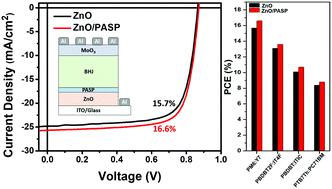当前位置:
X-MOL 学术
›
J. Mater. Chem. C
›
论文详情
Our official English website, www.x-mol.net, welcomes your
feedback! (Note: you will need to create a separate account there.)
A biopolymeric buffer layer improves device efficiency and stability in inverted organic solar cells
Journal of Materials Chemistry C ( IF 5.7 ) Pub Date : 2020-09-07 , DOI: 10.1039/d0tc03048a Nafees Ahmad 1, 2, 3, 4, 5 , Li Yanxun 1, 2, 3, 4, 5 , Xuning Zhang 5, 6, 7, 8, 9 , Boxin Wang 1, 2, 3, 4, 5 , Yuan Zhang 5, 6, 7, 8, 9 , Huiqiong Zhou 1, 2, 3, 4, 5
Journal of Materials Chemistry C ( IF 5.7 ) Pub Date : 2020-09-07 , DOI: 10.1039/d0tc03048a Nafees Ahmad 1, 2, 3, 4, 5 , Li Yanxun 1, 2, 3, 4, 5 , Xuning Zhang 5, 6, 7, 8, 9 , Boxin Wang 1, 2, 3, 4, 5 , Yuan Zhang 5, 6, 7, 8, 9 , Huiqiong Zhou 1, 2, 3, 4, 5
Affiliation

|
Interfacial modification is a key approach to improve performance in organic photovoltaic devices. Here, we demonstrate an environmentally friendly interfacial modifier, polyaspartic acid (PASP), which is inserted between ZnO and photoactive layers in inverted organic solar cells. The power conversion efficiency (PCE) of these solar cells based on a PM6:Y7 bulk heterojunction is boosted from 15.7% to 16.6%, due to a concurrently higher short-circuit current and fill factor. Revealed by electron spin resonance (ESR) spectroscopy coupled with charge transport measurements, the existence of an interfacial doping effect in ZnO/PASP induced by PASP was examined. An appropriate work function and surface wettability with a homogenous surface morphology are observed in ZnO/PASP electron transporting layers (ETLs). Furthermore, the optimized ETLs show universal applicability and enable better device stability. This work offers exciting prospects for using environmentally friendly materials to enrich our understanding of the interfacial properties of inverted OSCs.
中文翻译:

生物聚合物缓冲层提高了倒置有机太阳能电池的器件效率和稳定性
界面改性是提高有机光伏器件性能的关键方法。在这里,我们演示了一种环保型界面改性剂聚天冬氨酸(PASP),该聚合物被插入ZnO和倒置有机太阳能电池中的光敏层之间。由于同时具有更高的短路电流和填充因子,这些基于PM6:Y7本体异质结的太阳能电池的功率转换效率(PCE)从15.7%提高到16.6%。通过电子自旋共振(ESR)光谱与电荷传输测量相结合,研究了PASP诱导的ZnO / PASP中界面掺杂效应的存在。在ZnO / PASP电子传输层(ETL)中观察到适当的功函数和具有均匀表面形态的表面润湿性。此外,经过优化的ETL显示出通用性,并实现了更好的设备稳定性。这项工作为使用环保材料丰富了我们对倒置OSC界面特性的理解提供了令人兴奋的前景。
更新日期:2020-10-19
中文翻译:

生物聚合物缓冲层提高了倒置有机太阳能电池的器件效率和稳定性
界面改性是提高有机光伏器件性能的关键方法。在这里,我们演示了一种环保型界面改性剂聚天冬氨酸(PASP),该聚合物被插入ZnO和倒置有机太阳能电池中的光敏层之间。由于同时具有更高的短路电流和填充因子,这些基于PM6:Y7本体异质结的太阳能电池的功率转换效率(PCE)从15.7%提高到16.6%。通过电子自旋共振(ESR)光谱与电荷传输测量相结合,研究了PASP诱导的ZnO / PASP中界面掺杂效应的存在。在ZnO / PASP电子传输层(ETL)中观察到适当的功函数和具有均匀表面形态的表面润湿性。此外,经过优化的ETL显示出通用性,并实现了更好的设备稳定性。这项工作为使用环保材料丰富了我们对倒置OSC界面特性的理解提供了令人兴奋的前景。











































 京公网安备 11010802027423号
京公网安备 11010802027423号